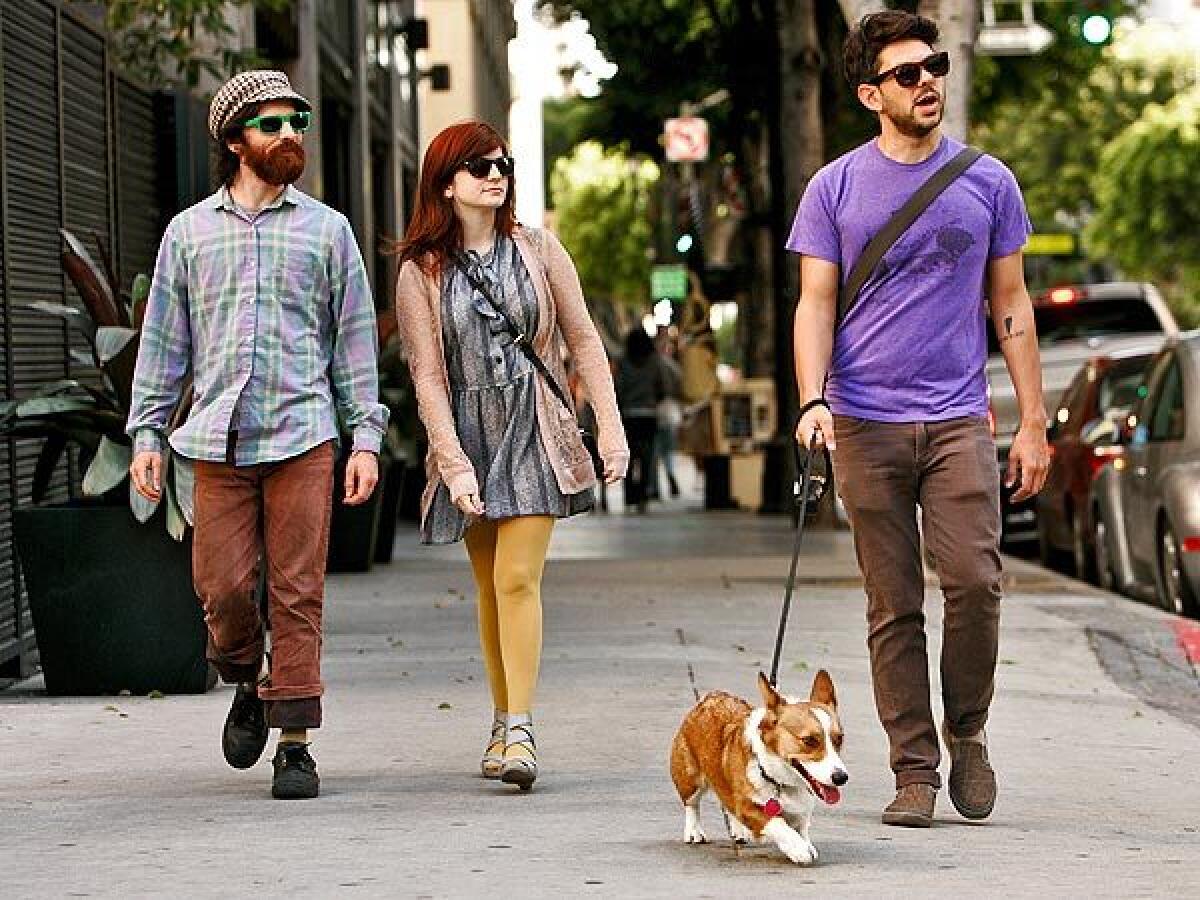A dog, a neighborhood and a different way of seeing

- Share via
My chow-shepherd Casey and I have walked the same streets for almost 15 years. Every morning, every night, seven days a week, rain or shine. Like most city dogs, Casey enforces this clause of the human-canine contract with meaningful looks, insistent pawing and (when all else fails) a snout-thrust to the laptop that allows no dissent.
I’d like to describe our hundreds of hours spent wandering the neighborhood as meditative, but they have often driven me nuts. Casey chooses the same route, greets whatever dogs are out, sniffs the same bushes from five angles before deigning to pee.
Still, the ritual has shifted some. Many familiar canine faces have vanished, and Casey’s painful shuffle tells me that our time together is short.
And lately, I’ve also come to realize what our walks have given me.
When I tell people about the pocket Westside neighborhood where I live, I always say I’ve never known or felt so deeply connected to a place. I realize now that’s not because my neighborhood is special. It’s because of Casey.
He is why I know every house around me — which lawns are always overgrown and which manicured, which yards have peach trees, and which cacti: walking at a dog’s pace forced me to see them. Casey is why I know every nearby family that ever had a dog, because he pulled me into the canine social orbit — of Blue and Sarah, on the next block; of big Valentine and golden Ollie and a dozen others.
The dogs in turn brought me into the lives of dozens of human neighbors. There was Frank, whose parents’ lives were ruined by the Cultural Revolution; Dan, the dogless dog-lover who drinks beer with friends outside his apartment, a giant jar of treats at his side. Some have become real friends, like Michelle, who came via Ava, a Great Dane mix and his sweet giant pack-mate Baxter. These people watch for me, ask after me, worry if I don’t show.
Fifteen years beside Casey have given me my own slice of Los Angeles. Work and politics and my daughter’s endless soccer games introduced me to a hundred neighborhoods sprawled across the basin. But I know them only from a distance, a camera’s panorama shot of mountains, the sweep of landscape framed by a car window. Walks with Casey are close-ups. I notice the increasingly neglected look of a home newly split by divorce and waiting for sale, the car whose weekly fender-bender damage suggests its driver’s dementia is worsening. In close up, the passage of time becomes concrete — the front lawn swing gives way to a soccer net; the porch steps are replaced by a wheelchair ramp.
The close-ups hold the quiet history of the streets themselves – the scrawled initials “CS 1973” in a driveway, the tiny plaque set in the sidewalk: “WPA 1940.” In our atomized, scattered world, there may be nothing else that roots one in a way so intensely, intimately local as walking the same streets, day after day, at a dog’s pace.
In L.A., 15 years is a long time. My tech-adjacent neighborhood is shifting, its 1940s bungalows giving way to large, white “modernist” boxes, its Subarus being replaced by Teslas. I feel the new world most acutely in the passing of the generation of dogs that first anchored me here. Val, Sarah and Blue are all gone. When Ollie died, his owner walked through the neighborhood crying, hiding Ollie’s rubber balls in bushes for other dogs to find. The day Ava died of cancer, I joined his owner to grieve beside his still body.
And yet, some things hold. Casey and I greet the few remaining old-timers including Albee, a white jindo, now deaf and stiff-legged with arthritis, who has always been Casey’s fiercest enemy. When we ran into him a few weeks ago, the two dogs paused to glare, their hackles raised, then both moved on. They’d still like to kill each other, but it just would be too much work.
As the new houses are finished, we meet the dogs and people who move in. There’s a young woman with a small, sweet-faced pit, a man whose bouncy long-legged mutt has the majestic name of Titan. We navigate the familiar streets, the phone pings relentlessly and headlines pull me toward the human world and its horrors, but Casey will not be rushed. Pee on this tree? No, maybe that one.
Meanwhile, I notice the cloud of purple bougainvillea that looks especially striking against a new home’s gray wall, and the spectacularly gnarled trunk of a 79-year-old pepper tree. Time must be taken, attention must be paid. It’s the gift dogs give us, and what they leave with us when they go.
Carol Mithers is a Los Angeles journalist and coauthor, with Leymah Gbowee, of the memoir “Mighty Be Our Powers: How Sisterhood, Prayer, and Sex Changed a Nation at War.”
More to Read
A cure for the common opinion
Get thought-provoking perspectives with our weekly newsletter.
You may occasionally receive promotional content from the Los Angeles Times.






